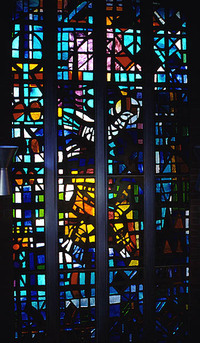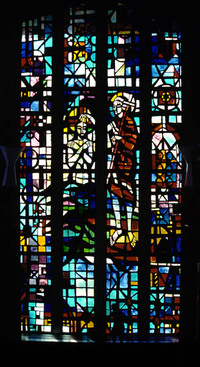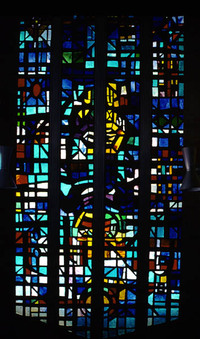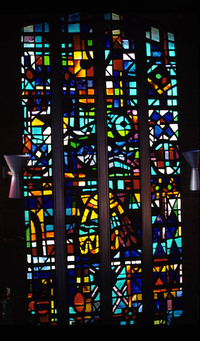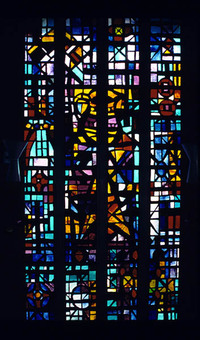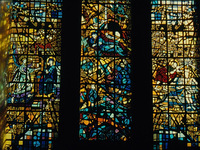MSGC : Featured Windows : Current Window
Featured Windows, November 2005
St. Joan of Arc Catholic Church
Buildings:
St. Lazarus Serbian Orthodox Cathedral - Detroit, Michigan
St. Joan of Arc Church - St. Clair Shores, Michigan
This month's featured windows are of faceted glass, designed by French stained glass artist Jean Barillet (1912-1997) and found in the baptistery at St. Joan of Arc Catholic Church. The windows are the "crown" of the baptistery, expressing Holy Baptism in abstract symbols including the fish, nets, sea of salvation and the baptism of Christ by John.
Jean Barillet followed in the footsteps of his father Louis Barillet (1880-1948), who had a stained glass studio in Paris. Louis was very influential in the evolution of contemporary stained glass in France as early as 1920, and a new book has just been published (in France) about his endeavors¹. Jean probably grew up assisting in the studio with simple tasks, but when he became an adult and more of a partner in the studio, the studio was selected by the French Commission of Historical Monuments to restore World War II damaged stained glass windows in Saint Chapelle and the Cathedral of Notre Dame in Paris, and the Cathedral of Beauvais. The influence of his father's involvement in the progression of contemporary stained glass and his association with some of the burgeoning artists in the field made Jean aware of the times in which he was growing up. As he became more involved in his father's studio, the studio began to fabricate windows for other French artists working in the new contemporary style. In the European system, the artist does not build the windows, but will carefully supervise glass selection and any additive treatments, such as painting or etching, all the way through the final output.
HISTORY OF DALLE DE VERRE
The genesis for dalle de verre (faceted) glass was the invention and use of reinforced concrete in the latter part of the 19th century. It was the refinement of the commercial use of this new ferro-concrete in Europe on bridges and buildings in the early part of the 20th century which "suggested" that chunks of glass embedded in concrete sidewalks would allow light into basements². The next obvious step was to use the same glass chunks in walls to allow light in, now with patterns of decorative abstraction and the human figure. Prior to this time, stained glass had been strictly a liturgical art with the glass pieces held together by a matrix of lead came.
There were those who lamented the use of the same old mundane images as mandated by the mainstream church. The flow of creativity from Impressionism to Cubism (which was "the modern art movement") combined with the new modern architecture, encouraged artists, sculptors, architects and craftsmen to collaborate their talents in the rebuilding of churches after World War I. This in turn was a catalyst for new images, themes and the use of new materials, which included dalle de verre/faceted glass, using reinforced concrete as the matrix. For her PhD from the University of Paris, Natalie Loire, granddaughter of Gabriel Loire (1904-1996-see Window of the Month,
November 2003) researched the designers of early dalle de verre. In the SGAA Reference and Technical Manual chapter on dalle de verre, she reports that the first faceted windows produced in France were after World War I, collaborations between an artist who designed the work and the glass studio that fabricated it.
As early as 1922, the French architect Auguste Perret is credited with using several walls pierced with faceted glass, facilitated by Maurice Denis and Marguerite Hure in Notre-Dame du Raincy, a concrete church in a Paris suburb. Several other French artists championed faceted glass in the mid 1930s-Auguste Labouret and Pierre Chaudière; Jean and Pierre Gaudin; and Charles Lorin and Gabriel Loire. Labouret is credited with the first faceted glass in North America, a church in Quebec, Canada. The Church of the Sacred Heart (Sacre Coeur) in Audincourt, France (Maurice Novarina, architect) is famous for its faceted glass designed by Fernand Léger, better known for his abstract painting. Our featured artist, Jean Barillet, fabricated a colorful band of 17 windows circling the sanctuary. In the United States, an early use of faceted glass was at
First Presbyterian Church in Stamford, CT. Constructed in the shape of a huge fish, the faceted glass was designed and fabricated by the Loire Studio in Chartres, France.
Barillet's work at the Church of the Sacred Heart in Audincourt, France. Photos by Barbara Krueger.
In the Autumn 1957 issue of
Stained Glass Quarterly, an article discusses a religious exhibit at New York's Museum of Contemporary Art where several panels of faceted glass "in the cement technique" were exhibited. The entire spring 1960 issue of
Stained Glass Quarterly was devoted to faceted glass, along with some advertisements for "slab setting compound," which was an epoxy resin. At this time the Blenko Glass Company in Milton, WV was the only US firm making glass dalles for use in faceted windows. In the
SGAA Reference & Technical Manual, John Kebrle, Natalie Loire, Richard Millard, Jim Perry and the late Walter Judson all discuss the intricacies of designing for faceted glass. Sometimes called slab glass, this medium has a look of mosaic or some might think "glowing" cement. In fact, from the exterior, some faceted glass windows seem to have so much matrix there might be little colored glass to be seen on the interior. However, it is the process of "faceting" or chipping the edges of the one-inch thick glass that allows light to be refracted and spread within the building so that in actuality, the effect is very brilliant.
An early US installation was in the Moreau Seminary Chapel on the campus of Notre Dame University in South Bend, IN. After seeing faceted windows in Europe, the Reverend Anthony Lauke of Notre Dame designed the windows and the Conrad Schmitt Studios of Wisconsin fabricated them. Another early application of faceted glass was in the Protestant Chapel at John F. Kennedy airport in New York. While the work was designed by Robert Pinart (1926-), Jean Barillet completed the fabrication in France. Early believers in the faceted glass system whose work appeared in trade publications included the Cummings Studio in San Francisco, Judson Studio in Pasadena, CA, Willet Studio in Philadelphia, Pittsburgh Stained Glass Studio, J&R Lamb Studio in New Jersey, and the Emil Frei Studio in St. Louis.
Barillet was selected by the Archdiocese of Hartford, CT³ to design and fabricate nave and side aisle windows for the new Cathedral of St. Joseph. The original building was destroyed by fire in late December 1958. Many major studios in the United States and Europe submitted designs and models, but Barillet was chosen to provide 26 windows that were each 67 feet high and 13 1/2 feet wide, as well as the 28' x 61' choir window and 10 smaller windows in the ambulatory. One of Barillet's interesting techniques, as noted by retired British stained glass artist Alfred Fisher, is how the use of color did not differentiate between the figures and the background. There were wide sweeps of color that would run from top to bottom or right to left. Because Barillet was very skillful in his use of negative space, it was still easy to "read" the windows, regardless of the color field.
After the archives of German/French/American stained glass artist
Helene Rother were given to the Michigan Stained Glass Census, it was discovered she had many maquettes by French stained glass artists, including Jean Barillet. It is very possible Ms. Rother's work was fabricated in the Paris studio of Jean Barillet, particularly her faceted windows at
St. Lazarus Serbian Orthodox Church in Detroit.
Faceted window by Helene Rother, St. Lazarus Serbian Orthodox Church, Detroit. Photo by Barbara Krueger.
Faceted glass, like any architectural art form waxes and wanes in prominence, due to a variety of reasons:
- The chapel with the Pinart windows at JFK airport was removed some years ago for a parking lot and the windows are supposedly in storage.
- The Fish Church in Stamford, CT is in the process of having all the faceted glass replaced. Due to the slanted wall construction, moisture eventually seeped between the glass and the concrete and froze, causing both concrete and glass to break apart.
- A church in England with faceted windows by Alfred Fisher will be demolished soon, as developers have made the church a monetary offer for the property.
- Newer building standards in the southern United States are strengthening the wind load requirements to such a point that the use of faceted glass has been on the decline. It seems to be unknown if there have been actual wind load tests of epoxy faceted glass vs. faceted glass in concrete.
- Within the past month, other Michigan windows with a Barillet connection have been discovered. In Saginaw, Temple B'nai Israel was built in 1964 with windows fabricated by Jean Barillet (designed by Dave B. Ruskin, MD, of Saginaw). The building has since been sold and the windows removed to storage.
St. Joan of Arc parish was founded in 1927 in St. Clair Shores and has been continually expanding - social hall converted to a small church in 1943; a 12-room school in 1946; larger church in 1952, now the gym; school addition in 1957; and the current church, designed by Robert L. Svoboda Associated Architects, was dedicated on August 26, 1965. Due to the available space, a rounded building was most practical to house the 1700 member parish.
St. Joan of Arc Catholic Church was photographed and registered in the Michigan Stained Glass Census by Ronald Prowse of Detroit.
Notes:
- The original Paris studio of Louis Barillet, Jean's father, has recently (2001-2005) undergone a major restoration and now is open to the public to see drawings and other aspects of the Barillets' careers in stained glass.
- Initially developed for use in US industry, by the late 1950s epoxy resin for the most part had replaced concrete as the matrix. It took less time for preparation than did concrete, was considerably lighter, and was easier to use and clean up. The surface could be "seeded" with a variety of materials, such as sand, pebbles and roofing granules, to approximate the finish of concrete.
- Many thanks to the Archdiocese of Hartford for providing a copy of the 1962 supplement to the Hartford Courant, and the cathedral dedication booklet.
Bibliography: Show Bibliography
"Philadelphia Resins Faceted Glass Competition." Stained Glass Quarterly (Winter 1965-66): 12-15.
Archdiocese of Hartford. "The Great Windows of the Cathedral of St. Joseph" (2005). http://www.archdioceseofhartford.org/cathedralwindows.htm.
Christatos, Marie-Helene. "Ignored Among U.A.M (Union of Modern Artists)., J. Louis Barillet: A Work of Light" (monograph -Paris, France, n.d.).
Farnsworth, Jean et al. Stained Glass in Catholic Philadelphia. Philadelphia: Saint Joseph's University Press, 2002.
Fisher, Alfred. Correspondence with author, October 2005.
Fisher, Alfred. "Observations on Some Recent French Work." Journal of the British Society of Master Glass Painters Vol. 8 No 3 (1961-62).
Frampton, Kenneth. Modern Architecture, A Critical History. London: Thames and Hudson, 1985.
Maddy, Dorothy et al, eds. SGAA Reference & Technical Manual: A Comprehensive Guide to Stained Glass. Lee's Summit, MO: Stained Glass Association of America, 1992.
Perrot, Francais. Chartres: Center International Du Vitrail, 1984.
Pinart, Robert. Telephone interview with author, September 22, 2005.
Reyntiens, Patrick. The Beauty of Stained Glass. Boston: Bullfinch Press, 1990.
St. Joan of Arc Catholic Community. "St. Joan of Arc Historical Essay" (n.d.). http://www.stjoanonline.org/stjoan.nsf/SBH/DA77A648AFC283A4852569B50063003F?OpenDocument.
St. Lazarus Serbian Orthodox Cathedral Ravanica. "The Architectural History of St. Lazarus Serbian Orthodox Cathedral Ravanica" (2004). http://www.ravanica.com/archit.htm
Willet, Muriel Crosby. "Religious Exhibition in New York." Stained Glass Quarterly (Autumn 1957): 117. (MSGC 1998.0050; 1994.0120)
Text by Barbara Krueger, Michigan Stained Glass Census, November , 2005.

